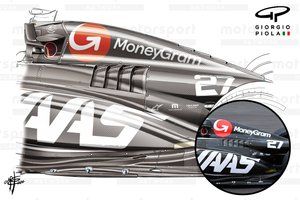How Williams has tamed its peaky F1 car
Williams came in to the 2021 Formula 1 season bracing itself for a rollercoaster season thanks to its car’s peaky aero characteristics.

Giorgio Piola's F1 technical analysis
Giorgio Piola is the preeminent Formula 1 technical journalist. Born in Genoa, Italy, Giorgio has covered the F1 World Championship since 1969, producing thousands of illustrations that have been reproduced in the world’s most prestigious motor racing publications.
Having already been through somewhat of a lean spell over the last few years in its fight to move off the bottom of the standings, its drivers were well aware of a wind sensitivity issue that made their car difficult to drive at times.
However, with fresh impetus and without the burden of designing an all-new chassis, Williams actually made some swift progress in putting the issue behind it.
Furthermore, a fairly sizeable upgrade introduced at the French Grand Prix helped unlock more of the car’s latent potential, and laid the foundations for its Q3 form in Austria.
Here we take a look at the upgrade that’s contributed to this upturn in performance.

Williams FW43B bargeboard comparison
Starting with the bargeboard cluster, the team didn’t feel the need to totally revamp the entire design.
Instead each of the alterations are about tuning the airflow to get a better response from them and deal with the wind sensitivity issue that the drivers mentioned in the early part of the season.
The outwash fins mounted on top the multi element footplate have been increased in number, not only in the stack that were already in situ (marked in green), but with a second row being introduced just behind (marked in red).
Meanwhile, drawing influence from McLaren, which has had a similar solution since last year, the team added a pair of downwash wings beneath the boomerang wing and created a framework for which the airflow can now operate within (marked in yellow).
The top of the main vertical element has also been adjusted (marked in blue) with the team following what has become a little bit of a trend, with the surface broken up into smaller feather-like sections.

William FW43B floor comparison
Williams was not long out of the gate before making the switch to the now almost ubiquitous Z-shaped floor cut-out, with the solution arriving at the second race of the season. However, the aerodynamic appendages used in combination with the cut-out remained largely the same, save the triple fin cluster added at the fulcrum.
The team has now replaced the three ‘r’ shaped vanes placed midway along the cut-out and the slightly curved fin just ahead of the tyre (marked in red) with a cluster of fins right on the edge of the floor (marked in green).
This is an attempt to replicate the sort of flow conditioning that was easier under the previous regulations, with the ability to control the ‘tyre squirt’ created by the rear tyre imperative to increasing the performance of the diffuser.
Left unchecked, the deformation of the tyre will squirt airflow laterally into the diffuser's path as it squishes under load.
The design of the floor and the aerodynamic devices installed on it are all looking to reduce this by redirecting the flow across and around the tyre, which as a consequence will improve the balance of the car and increase downforce.

William FW43B floor fins
Williams had already looked at this earlier in the season when it exchanged the triple winglet stack mounted horizontally that it had also used throughout the 2020 campaign for a vertical fence, similar to what we’ve seen Ferrari use this year too.
Interestingly this aligns neatly with a vertical fin mounted on the rear brake duct winglet cluster, which as we know are also narrower this year by regulation.
The update package run since the French GP has also featured a revised diffuser layout too, as the team has reduced the height of the outermost strake, a decision we’ve seen several teams take this season. This suggests that the new regulations have altered the course of the airflow sufficiently in that region for the teams to feel that they needed to make adjustments.

William FW43B diffuser comparison
Be part of the Autosport community
Join the conversationShare Or Save This Story
Related video
Subscribe and access Autosport.com with your ad-blocker.
From Formula 1 to MotoGP we report straight from the paddock because we love our sport, just like you. In order to keep delivering our expert journalism, our website uses advertising. Still, we want to give you the opportunity to enjoy an ad-free and tracker-free website and to continue using your adblocker.















Top Comments